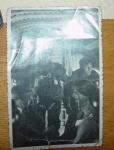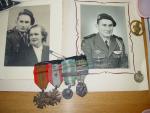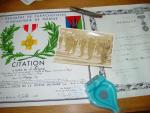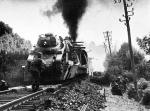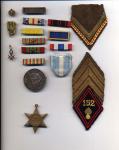-
Posts
2,284 -
Joined
-
Last visited
-
Days Won
6
Content Type
Profiles
Forums
Blogs
Gallery
Events
Store
Everything posted by PKeating
-
Looks like a nice example of a locally-produced 1939 CdG to me, quite typical of crosses made in the French colonies. Many of them were certainly cast. I have seen large format 1939 and 1939-1940 dates on struck crosses, most likely made in major colonial cities like Algiers and Saigon. The 1939 CdG was the only official Republican issue, although the postwar 1939-1945 crosses have come to be seen as official even though they aren't. While this cross was not produced by the Paris mint, it is 'official' in that it conforms to official guidelines despite its artisanal appearance. PK
-
Boonzaier just said it for me. Amazing career! As I am sure you know, the «Vichy» Croix de Guerre was authorised for those who had earned the CdG in the War of 1939-40. He would have worn that cross and its corresponding ribbon during much of his time in Algeria in 1940-1943, when his unit came under Free French control, at which point he would have reverted to the Republican ribbon. Do you have his award documents? PK
-
True. It would have been great had his other citations been there, along with his numbered jump badge. He may have lost the WW2 and Indo-China stuff himself at some point. Who knows? But it is still a wonderful grouping to rescue, such as it is.
-
Correction. On examining a blow-up of the medals parade photo, Soupize is actually receiving the Médaille Militaire, which dates it to 1958. The print bears the stamp of an Algiers photographer on the back. This puts Soupize in the 6e RPC. The regimental badge he wears in the other photo is either 6e BCP or RCP. Hard to tell, no matter how much I blow it up. PK
-
Pretty good! CITATION à l’ordre de la Brigade Ordre Général N° : 206, en date du: 11 Juin 1962, du Général de Brigade Le Masson, Commandant la Région Territoriale et le Corps d’Armée d’Alger. Sergent-Chef SOUPIZE Serge “Chef dépanneur de la Compagnie Portée a participé depuis Février 1961 à toutes les opérations de l’Unité et s’est acquis en ces circonstances l’admiration et la confiance de tous. Dans des conditions toujours difficiles et souvent périlleuses, se déplaçant sur des pistes peu sûres et souvent minées avec un retard parfois considérable sur le reste de l’Unité, a toujours réussi à ramener son matériel au complet. Par sa compétance et son travail acharné, a réussi à maintenir intact le potentiel matériel de la Compagnie en même temps qu’il présurait le moral de son personnel par son allant et sa gaité. A été la cheville ouvière de la bonne marche de l’Unité. Cette Citation comporte l’attribution de la CROIX DE LA VALEUR MILITAIRE avec Étoile de Bronze. Pour copie certifiée conforme: à S.P. 86.031, le 1er Juillet 1962. Le Colonel Cdt le 3me R.P.I.M.A. Signed on behalf of the Colonel, who would have been, I think, Guy Le Borgne. The citation is A3. It really is pretty impressive, and filled out neatly in fountain pen with just one tiny error. Translation follows when I have a spare moment. PK
-
Parachute School, judging by the prewar-style jump helmets. This seems to be a Junkers Ju52, if my memory of the interior of these planes serves me correctly. So, while there is research to be done, it is possible that Serge Soupize, already a veteran of the NW Europe campaigns of 1944 and 1945 with the Croix de Guerre to his name, underwent parachute training in the late 1940s. Had he been a wartime para, he would probably have been trained by the British at Ringway. However, born on 14.8.1928, he was in all likelihood one of the young recruits to the Gaullist army as it swept across France. There are also some 1940s photos of him in US Army kit as issued to various units of the Forces françaises libres as well as photos apparently taken on leave in France in the early 1950s in which he wears a greatcoat obscuring any unit insignia but sports a para beret and badge. In one of the portraits, Soupize seems to be wearing the regimental badge of the 6e Régiment parachutiste de l'infantérie de la marine or 6e RPIMa, which makes sense as he was decorated with the Médaille Militaire on 14.8.1958 and his certificate is dated 17.3.1959, the 6e RPIMa having been formed from the 6e Régiment de parachutistes coloniaux on 1.12.1958. The Croix de la Valeur Militaire document dated 1.7.1962 states that he had taken part in all of the 3e RPIMa operations since February 1961 so he must have transferred from the 6th Regiment, which left Algeria in 1961. One can see the ribbons of the Médaille Militaire, CdG 1939, CdG TOE, CdC, Médaille Coloniale with Extreme-Orient clasp, 1939-1945 War Medal with the Libération and Allemagne clasps and two other ribbons, one of which seems to be the campaign medal for the Algerian War or «Maintien de l'Ordre» operation, as it was euphemistically described. The second-last ribbon looks like the Indo-China War medal with what seems to be an unofficial clasp. Perhaps someone can take a better guess. I will scan and enlarge it as soon as possible. Anyway, this sort of citation is very seldom seen, a citation to a Senior Para NCO for Algeria, complete with a photo of the man having the medal pinned on. Now, who can show us some more? PK
-
Serge Soupize fought with the Colonial Infantry in WW2, Indo-China and Algeria. Judging by the photo taken inside what looks like a Ju52 transport plane, he qualified as a parachutist in the late 1940s. Sadly, the grouping of photos, medals and documents is not complete but the award document for the Croix de la Valeur complete with a photo of Sérgeant Chef Soupize receiving his CdV in Algiers in 1962 couldn't be passed up. He was already a holder of the Médaille Militaire, the Croix de Guerre 1939 with Bronze Star, the Croix de Guerre TOE with Bronze Star and the Croix du Combattant, and would be appointed Chévalier of the Order of Merit in 1972. Some of his medals, mounted as he would have worn them between Indo-China and Algeria, were included, along with a few in boxes. Sadly, his jump badge was not amongst the stuff found in an old suitcase.
-

18 place ribbon bar possible?
PKeating replied to paddywhack's topic in Great Britain: Orders, Gallantry, Campaign Medals
Not an ISM but perhaps a faded DCM riband? PK -
We had an identical opener but in silver-grey galvanised finish in our ration packs (British) as issued from the 1970s to the 1990s. I don't know if they're still issued in current ration packs. I have a few somewhere and if I can find them, I'll post one. One of the best designs I have come across for can-opening without lacerating oneself! PK
-
I have only seen caps like this in a couple of photographs. It is in amazing condition and the badge, which may be a private purchase item like some of the regular police officer's quality sleeve eagles one sometimes sees, is of a rarely-seen quality too. The bullion national rondel is a chic touch too. The officer who wore this obviously had a sense of sartorial style. I bet his tunics were top grade too. PK
-
Sad to learn but thanks for the heads-up. At least I know what to expect now. Mind you, I sometimes wonder if Ireland's lack of dealers in general means that there is more stuff in the possession of families, waiting to be discovered. PK
-

EK 1939 EK1 just in, could the members please comment
PKeating replied to Brian Wolfe's topic in Germany: All Eras: The Iron Cross
Well, nobody can know everything about everything. Wasn't actually trying to wind you up or anything. The rest of your post was absolutely spot-on. Some recipients did try to bend them, with the results you describe. However, vaulted 1939 EK1 were produced and a few were awarded, as award pieces, before they were definitely outlawed, along with other variations that found disfavour with Dr Doehle and his office. At least a couple of sections, for example, of the Eben Emael assault force received them, as did various soldiers during the Polish campaign. I have a couple of examples of these early vaulted crosses. -

EK 1939 EK1 just in, could the members please comment
PKeating replied to Brian Wolfe's topic in Germany: All Eras: The Iron Cross
I'm afraid your first two statements are a bit wide of the mark. PK -
Super photo! The Gloster Whittle's maiden flight was on 15.5.1941. Many people think we beat the Jerries to jet flight but Heinkel put a prototype in the air in August 1939. There's an original example in the London Science Museum and a replica on a roundabout near the Farnborough aerodrome in Hampshire, south-west of London. The Gloster Whittle's maximum speed was less than 350 mph, however, so it wasn't suitable for development as an operational fighter. However, it paved the way for the Gloster Meteor, which did fly operationally before the end of WW2. Thanks for posting this. I thing Frog and Airfix made models of this aircraft in the late 1960s. I remember building and painting the Frog version. PK
-

Fake The ultra rare 57 Diamonds!
PKeating replied to Hauptmann's topic in Germany: All Eras: The Iron Cross
These are in fact absolutely genuine austerity pattern Diamonds from April/May 1945, according to some sources, and were made by the same firm that produced the Rounder Knight's Cross. -
http://gmic.co.uk/index.php?showtopic=44030&st=0&p=407096&#entry407096
-
Here's another interesting scene in which a light tank is dispatched into the woods lining the track to chase down the maquisards. Anyway, get the DVD. Even if you don't speak French, it's usually subtitled and it is in any case very interesting from the viewpoint of the original equipment, vehicles and some of the more spectacular sabotage scenes. PK
-
Just to add a footnote to Vétéran's post: he mentioned La bataille du rail. There is an extraordinary film of that name - http://www.amazon.com/Bataille-du-Rail-Charles-Boyer/dp/B000CEV3BO - which won the International Prize at Cannes in 1946 and is one of the few seriously gritty, realist French films dealing with the Occupation and the Resistance. It was filmed in 1945 and released in 1946 and cannot be too highly recommended for students of this period in French history. Below is a location still showing the filming of the scene where several cheminots are summarily shot following acts of sabotage in the marshalling yards. PK
-
Frank, I'm afraid that the shops to which you refer - Marie Stuart, or the small place at the junction of rue Molière and rue de Richelieu, the outrageously-priced place in the basement of les Antiquaires du Louvre etc - really are the only possibilities in Paris these days, except for one chap who has a stall/boutique hidden away in the Clignancourt market on Sundays and Mondays. He usually has some nice 19th century medals. There are a couple of dealers in the provinces, like Robert Seniso, who have nice things and can sometimes find you something special for which you are searching. Remember this: prices of French stuff are going up now and as someone once told me, it is often a good idea to pay tomorrow's price to have something very nice today. The alternative is that someone in Paris keeps an eye out for a nice example - original or, at least, very old ribbon included - and gets in touch when it crops up. PK
-
Bonjour Paul! Thank you very much for this fascinating piece of information. It is true, now I come to think of all the photos I have seen of veterans in general, not just legionnaires, taken from the 1940s to the 1980s, that I cannot recall seeing the Gaullist Médaille Commémorative du Levant amongst the medals adorning proud chests. It is quite a distinctive ribbon and one would notice it. I have seen the 1922 medal in photos from the 1920s and 1930s but, of course, the "Levant - 1941" clasp was forbidden in 1944. I wonder how many Germans and Italians were serving in both Légion étrangère units at the time. PK
-
Chris, the British Star-like medal is Nigerian: For Bravery. It seems to have been struck on WW2 star dies with a different centre. I'll be posting in the appropriate section in due course. The minis are the WW1 French Victory Medal and the Voluntary Combattants Cross. I like the way some veteran, when it broke, sewed it onto the ribbon...upside-down. The Wound Ribbon is very nice, isn't it? I also like the WW1 CdG with the tiny Palm. The painted/printed ribbon bars are not often seen, Noor. However, I do know of a little box containing a few of them, which I think I will buy. Dublin is, sadly, not the best of places for militaria. I grew up in Upper Mount Street in the 1960s and often go back as I still have family there. I've only seen two militaria dealers there in recent years. That's the great thing about our hobby, isn't it? Things don't have to be top end or hyper-expensive to give you a thrill when you find them and to give others pleasure. P
-
Funnily enough, these ribbon bars are getting hard to find. The WW1 Italian War Medal mounted in the French style is interesting, as is the painted tin WW1 Croix de Guerre ribbon. Not bad for €5.00 in a flea market where I almost died of boredom.




